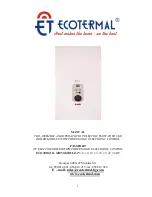
55
LP- 325 REV. 3.3.15
DO NOT USE THIS APPLIANCE IF ANY PART HAS BEEN SUBMERGED IN WATER.
Immediately call a qualified service technician.
The appliance MUST BE replaced if it has been submerged. Attempting to operate an appliance that has been submerged could create
numerous harmful conditions, such as a potential gas leakage causing a fire and/or explosion, or the release of mold, bacteria, or other
harmful particulates into the air. Operating a previously submerged appliance could result in property damage, severe personal injury,
or death.
NOTE:
Appliance damage due to flood or submersion is considered an Act of God, and IS NOT covered under product warranty.
Do not use petroleum-based cleaning or sealing compounds in appliance system. Damage to elastomer seals and gaskets in system
could occur, resulting in substantial property damage.
A. CHECK FOR GAS LEAKS
Before starting the appliance and during initial operation, smell near the floor and around the appliance for gas odorant or any unusual
odor. Remove appliance front door and smell interior of appliance enclosure. Do not proceed with startup if there is any indication of a
gas leak. Repair any leaks at once.
PROPANE ONLY
– Propane suppliers mix an odorant with the gas to make its presence detectable. In some instances, the odorant
can fade, and the gas may no longer have an odor. Before startup and periodically thereafter, have the propane supplier verify the
correct odorant level in the gas.
B. CHECK/CONTROL HYDRONIC WATER CHEMISTRY
Water pH between 6.0 and 8.0
1. Maintain appliance water pH between 6.0 and 8.0. Check with litmus paper or have chemically analyzed by a water treatment
company.
2. If the pH differs from above, consult local a water treatment company for treatment required.
Hardness less than 7 grains
Consult local water treatment companies in circumstances of unusually hard water (above 7 grains hardness).
Chlorine concentration less than 100 ppm
1. Filling with chlorinated fresh water should be acceptable since drinking water chlorine levels are typically less than 5 ppm.
2. Do not use the appliance to directly heat swimming pool or spa water.
3. Do not fill appliance or operate with water containing chlorine in excess of 100 ppm.
Clean system to remove sediment
1. You must thoroughly flush the system (without the appliance connected) to remove sediment. The high-efficiency heat exchanger
can be damaged by buildup or corrosion due to sediment.
2. For zoned systems, flush each zone separately through a purge valve. (If purge valves and isolation valves are not already installed,
install them to properly clean the system.)
3. Flush system until water runs clean and you are sure piping is free of sediment.
C. VERSA-FLAME DHW HEAT PACK WATER QUALITY
Chemical imbalance of your water can cause severe damage to your appliance and associated equipment, and may also affect
efficiency. You may have to have your water quality professionally analyzed to determine whether you need to install a water softener.
It is important that the water chemistry on both the domestic hot water and central heating sides are checked before installing the
appliance, as water quality will affect the reliability of the system. Outlined below are those water quality parameters which need to be
met in order for the system to operate efficiently for many years.
Failure of a heat exchanger due to lime scale build-up on the
heating surface, low pH or other imbalance IS NOT covered by the warranty.
Summary of Contents for Pioneer
Page 17: ...17 LP 325 REV 3 3 15 Figure 3 Dimensions ...
Page 28: ...28 LP 325 REV 3 3 15 Figure 9 DHW Pack Performance on 199K BTU Models ...
Page 44: ...44 LP 325 REV 3 3 15 Figure 20 ...
Page 47: ...47 LP 325 REV 3 3 15 Figure 22 Internal Wiring Diagram ...
Page 67: ...67 LP 325 REV 3 3 15 Figure 30 Pioneer and Versa Flame ...
Page 68: ...68 LP 325 REV 3 3 15 Figure 31 Pioneer and Versa Flame ...
Page 71: ...71 LP 325 REV 3 3 15 ...
Page 72: ...72 LP 325 REV 3 3 15 ...
















































